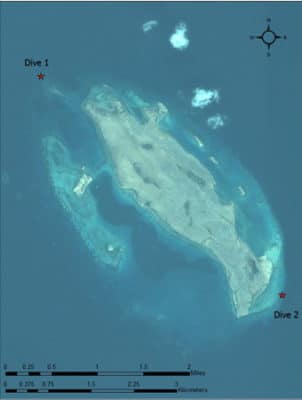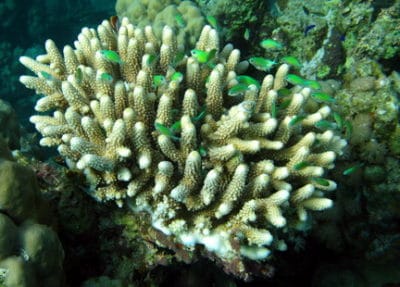Saturday, April 4. Our research team boarded the Golden Shadow on Saturday morning, departing from Jeddah, Saudi Arabia around mid day for a 7 hour (120 mile) journey to the northern end of the Farasan Banks. We reached our first anchorage about 10 km north of Abu Latt Island just after dark.

Al Rajhee shrimp farm and Abu Latt
Sunday, April 5. For our first set of dives we surveyed reefs off Abu Latt Island. The island is located approximately 15 miles offshore from the coastal town of Al Lith. Just north of town is a large lagoon, with extensive mangroves and the world’s largest desert coastal shrimp farm, Al Rajhee. As of 2006, Al Rajhee had developed 6000 hectares of shrimp ponds, capable of producing 30,000 metric tons of shrimp annually; about 80% of these shrimp are destined for Japan, United States, Australia, China, Singapore, South Korea and Thailand. This farm has adopted best management practices, including use of sediment basins to reduce effluent; chemical and antibiotic free farming operations; protection of mangroves; lowering of nutrients; and selective breeding practices.

Location of our first dives off Abu Latt Island
Abu Latt island has extensive seagrass in shallow water, sandy beaches that are important turtle nesting areas, and several uplifted limestone terraces and hills.
Our first dive was a fore reef community off the northern end of the island. This reef had a well developed and rich shallow slope, extending from about 3-4 m to 12 m depth, with high cover of Millepora and Acropora.
Coral spurs with moderate relief (1-4 m), separated by patches of sand and coral rubble, extend into deeper water. Consisting primarily of a Porites framework, these spurs had relatively low coral cover (5-20%) but high diversity.
Some of the largest corals included Diploastrea, Porites, Favia stelligera, and Hydnophora, while the most abundant taxa were Pocillopora, Porites and Goniastrea. Although there were many small dead corals and quite a bit of partial mortality, only isolated cases of disease (white syndrome) and predation (Drupella snails) were apparent. Many colorful smaller reef fishes were seen, along with several larger grouper, snapper and a single shark.

A colorful colony of Lobophyllia
The second dive consisted of a well developed columnar Porites framework up to about 10 m relief, with deep depressions filled with fine sediments. Deeper areas had fairly low cover, and mostly small corals, bit a fairly high diversity. Shallow areas (5-10 m depth) were dominated by large colonies of Porites, with an encrusting and massive growth forms, occurring in places at very high cover. While many small table Acropora and Millepora colonies occur in shallow water, larger colonies were dead and broken down and there was no clear Acropora zone. This area appears to be recovering from a past disturbance. Disease prevalence was low, with isolated cases of white syndrome seen on Stylophora, Porites and Acropora. A number of sponges were seen encrusting and overgrowing corals as were mats of cyanobacteria. There also were a relatively high abundance of giant clams.

Blue green Chromis (Chromis viridis) near a digitate Acropora colony